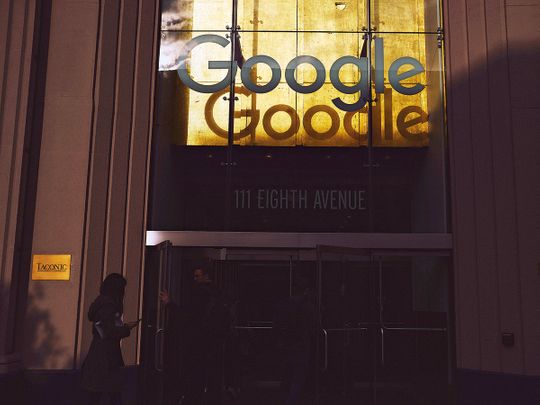
When detectives in a Phoenix suburb arrested a warehouse worker in a homicide investigation last December, they credited a new technique with breaking open the case after other leads went cold.
The police told the suspect, Jorge Molina, they had data tracked his phone to the site where a man was shot nine months earlier. They had made the discovery after obtaining a search warrant that required Google to provide information on all devices it recorded near the killing, potentially capturing the whereabouts of anyone in the area.
The Arizona case demonstrates the promise and perils of the new investigative technique, which has risen sharply in recent times - it can help solve crimes, but can also snare innocent people.
Investigators also had other circumstantial evidence, including security video of someone firing a gun from a white Honda Civic, the same model that Molina owned, though they could not see the license plate or attacker.
But after he spent nearly a week in jail, the case against Molina fell apart as investigators learnt new information and released him. Last month, the police arrested another man: his mother’s ex-boyfriend, who had sometimes used Molina’s car.
The warrants, which draw on an enormous Google database employees call Sensorvault, turn the business of tracking cell phone users’ locations into a digital dragnet for law enforcement. In an era of ubiquitous data gathering by tech companies, it is just the latest example of how personal information — where you go, who your friends are, what you read, eat and watch, and when you do it — is being used for purposes many people never expected.

As privacy concerns have mounted among consumers, policymakers and regulators, tech companies have come under intensifying scrutiny over their data collection practices.
The Arizona case demonstrates the promise and perils of the new investigative technique, whose use has risen sharply in the past six months, according to Google employees familiar with the requests.
It can help solve crimes. But it can also snare innocent people.
Technology companies have for years responded to court orders for specific users’ information. The new warrants go further, suggesting possible suspects and witnesses in the absence of other clues. Often, the company responds to a single warrant with location information on dozens or hundreds of devices.
Law enforcement officials described the method as exciting, but cautioned that it was just one tool.
“It doesn’t pop out the answer like a ticker tape, saying this guy’s guilty,” said Gary Ernsdorff, a senior prosecutor in Washington state who has worked on several cases involving these warrants. Potential suspects must still be fully investigated, he added. “We’re not going to charge anybody just because Google said they were there.”

It is unclear how often these search requests have led to arrests or convictions, because many of the investigations are still open and judges frequently seal the warrants. The practice was first used by federal agents in 2016, and first publicly reported last year in North Carolina. It has since spread to local departments across the country, including in California, Florida, Minnesota and Washington. This year, the company received as many as 180 requests in one week. Google declined to confirm precise numbers.
The technique illustrates a phenomenon privacy advocates have long referred to as the “if you build it, they will come” principle — anytime a technology company creates a system that could be used in surveillance, law enforcement inevitably comes knocking. Sensorvault includes detailed location records involving at least hundreds of millions of devices worldwide and dating back nearly a decade.
Sensorvault includes detailed location records involving at least hundreds of millions of devices worldwide and dating back nearly a decade.
The new orders, sometimes called “geofence” warrants, specify an area and a time period, and Google gathers information from Sensorvault about the devices that were there. It labels them with anonymous ID numbers, and detectives look at locations and movement patterns to see if any appear relevant to the crime. Once they narrow the field to a few devices they think belong to suspects or witnesses, Google reveals the users’ names and other information. ‘’There are privacy concerns that we all have with our phones being tracked — and when those kinds of issues are relevant in a criminal case, that should give everybody serious pause,” said Catherine Turner, a Minnesota defence lawyer who is handling a case involving the technique.
Investigators said they had not sent geofence warrants to companies other than Google, and Apple said it did not have the ability to perform those searches. Google would not provide details on Sensorvault, but Aaron Edens, an intelligence analyst with the sheriff’s office in San Mateo County, California, who has examined data from hundreds of phones, said most Android devices and some iPhones he had seen had this data available.
In a statement, Richard Salgado, Google’s director of law enforcement and information security, said that the company tried to “vigorously protect the privacy of our users while supporting the important work of law enforcement.” He added that it handed over identifying information only “where legally required.”

Molina, 24, said he was shocked when the police told him they suspected him of murder, and he was surprised at their ability to arrest him based largely on data. “I just kept thinking, You’re innocent, so you’re going to get out,” he said, but he added that he worried that it could take months or years to be exonerated. “I was scared,” he said.
Detectives have used the warrants for help with robberies, sexual assaults, arsons and murders. Last year, federal agents requested the data to investigate a string of bombings around Austin, Texas. Austin investigators obtained another warrant after a fourth bomb exploded. But the suspect killed himself three days after that bomb, as they were closing in. Officials at the time said surveillance video and receipts for suspicious purchases helped identify him. An FBI spokeswoman declined to comment on whether the response from Google was helpful or timely, saying any question about the technique “touches on areas we don’t discuss.”
Officers who have used the warrants said they showed promise in finding suspects as well as witnesses who may have been near the crime without realising it. The searches may also be valuable in cold cases. A warrant last year in Florida, for example, sought information on a homicide from 2016. The approach has yielded useful information even if it wasn’t what broke the case open, investigators said. In a home invasion in Minnesota, for example, Google data showed a phone taking the path of the likely intruder, according to a news report and police documents. But detectives also cited other leads, including a confidential informant, in developing suspects. Four people were charged in federal court.
Current and former Google employees said they were surprised by the warrants. Brian McClendon, who led the development of Google Maps and related products until 2015, said he and other engineers had assumed the police would seek data only on specific people. The new technique, he said, “seems like a fishing expedition.”
The practice raises novel legal issues, according to Orin Kerr, a law professor at the University of Southern California and an expert on criminal law in the digital age. One concern: the privacy of innocent people scooped up in these searches. Several law enforcement officials said the information remained sealed in their jurisdictions but not in every state. “Normally we think of the judiciary as being the overseer, but as the technology has gotten more complex, courts have had a harder and harder time playing that role,” said Jennifer Granick, surveillance and cybersecurity counsel at the American Civil Liberties Union. “We’re depending on companies to be the intermediary between people and the government.”
But despite the drawbacks, detectives noted how precise the data was and how it was collected even when people weren’t making calls or using apps — both improvements over tracking that relies on cell towers. “It shows the whole pattern of life,” said Mark Bruley, the deputy police chief in Brooklyn Park, Minnesota, where investigators have been using the technique since this fall. “That’s the game changer for law enforcement.”
Google’s Sensorvault Is a Boon for Law Enforcement. This Is How It Works
Law enforcement officials across the US have been seeking information from a Google database called Sensorvault — a trove of detailed location records involving at least hundreds of millions of devices worldwide, The New York Times found. Though the new technique can identify suspects near crimes, it runs the risk of sweeping up innocent bystanders, highlighting the impact that companies’ mass collection of data can have on people’s lives.
The Sensorvault database is connected to a Google service called Location History. The feature, begun in 2009, involves Android and Apple devices. Location History is not on by default. Google prompts users to enable it when they are setting up certain services — traffic alerts in Google Maps, for example, or group images tied to location in Google Photos. If you have Location History turned on, Google will collect your data as long as you are signed in to your account and have location-enabled Google apps on your phone. The company can collect the data even when you are not using your apps, if your phone settings allow that.
Google can also gather location information when you conduct searches or use Google apps that have location enabled. If you are signed in, this data is associated with your account. The Associated Press reported last year that this data, called Web & App Activity, is collected even if you do not have Location History turned on. It is kept in a different database from Sensorvault, Google says.
To see some of the information in your Location History, you can look at your timeline. This map of your travels does not include all of your Sensorvault data, however. Raw location data from mobile devices can be messy and sometimes incorrect. But computers can make good guesses about your likely path and about which locations are most important. This is what you see on your timeline. To review all of your Location History, you can download your data from Google. To do that, go to Takeout.Google.com and select Location History. You can follow a similar procedure to download your Web & App Activity on that page. Your Location History data will appear in computer code. If you can’t read code, you can select the “JSON” format and put the file into a text editor to see what it looks like.
The process varies depending on whether you are on a phone or computer. In its Help Centre, Google provides instructions on disabling or deleting Location History and Web & App Activity.
For years, police detectives have given Google warrants seeking location data tied to specific users’ accounts.
But the new warrants, often called “geofence” requests, instead specify an area near a crime. Google looks in Sensorvault for any devices that were there at the right time and provides that information to the police.
Google first labels the devices with anonymous ID numbers, and detectives look at locations and movement patterns to see if any appear relevant to the crime. Once they narrow the field to a few devices, Google reveals information such as names and email addresses.








